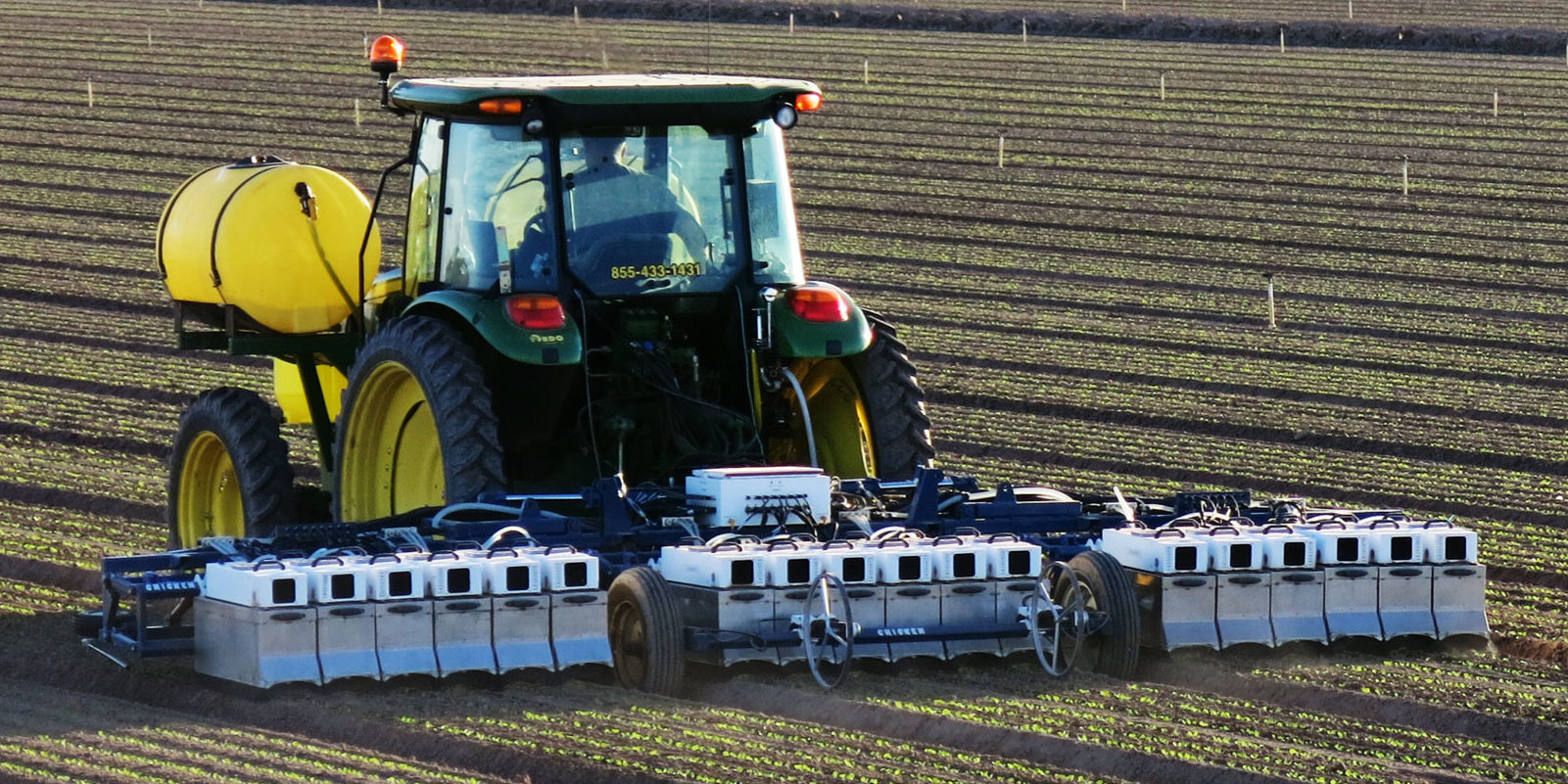PRE2016 3 Groep1: Difference between revisions
No edit summary |
No edit summary |
||
| Line 59: | Line 59: | ||
A company called Blue River created a robot which can identify weed and excess planted lettuce plants with the use of image recognition. When it is determined which plants need to be removed, the robot sprays a little amount of herbicide on it. This can result in a 90% reduction of use of perticides. Currently the robot is towed behind a conventional tractor, but Blue River is working on an fully automated version of the LettuceBot. | A company called Blue River created a robot which can identify weed and excess planted lettuce plants with the use of image recognition. When it is determined which plants need to be removed, the robot sprays a little amount of herbicide on it. This can result in a 90% reduction of use of perticides. Currently the robot is towed behind a conventional tractor, but Blue River is working on an fully automated version of the LettuceBot. | ||
[[File:Lettucebot.jpg |700px]][[File:LettuceBot1-200x100-e1464046090244.jpg|700px]] | |||
---- | ---- | ||
Revision as of 11:19, 15 February 2017
Presentation 1:
Problem description Design of a system for argicultural application capable of reacting to data aquired from aerial photo's.
Objectives
The system must
- use drones to aquire data
- analyse the data
- react to the results of the analysis
approach
-research state of the art
-abstract from state of the art
-contact with user
-Create model
-analyse impact
USE aspects
-Societal problem of hunger
-Cheaper food for user
-Cheaper then workers in the long run
State of the art automated argiculture
Weeding
There are some quite exciting technological developments going on in the area of automated weeding. The most important technologies will be discussed below.
Deepfield Weeding Robot
The first far-developed technology is the Deepfield Weeding robot of Bosch, see below.
This robot has GPS navigation to move through the fields with a 90% electrical efficiency. A row of linear actuators is attached to the bottom of the robot. When the robot detects weed is punched one of the actuators in the ground the destroy the little plant. The company claims that the positions accuracy is 2 mm and that it can remove 20 weeds per second. Given 40 weeds per square meter, the robot can process a hectare in three hours. The machine will cost about the same as a midsized tractor (http://www.dairyherd.com/news/german-company-demonstrates-automated-weeding-machine).
Advantages of this design:
- Herbicide-free farming
- Relative fast operation
Disadvantages of this design:
- Only suitable for small weeds
- Only suitable for field with small crops
There is also an other variant of this machine under development. This machine looks almost the same, but it does use herbicides. A greater working with of six to seven meters is possible with foldable booms. This machine will still lead to massive herbicide savings, but with a much bigger capacity potential.
LettuceBot
A company called Blue River created a robot which can identify weed and excess planted lettuce plants with the use of image recognition. When it is determined which plants need to be removed, the robot sprays a little amount of herbicide on it. This can result in a 90% reduction of use of perticides. Currently the robot is towed behind a conventional tractor, but Blue River is working on an fully automated version of the LettuceBot.
References
-Company that makes ground scans and 3D scans with drones: https://3dr.com/ -Drones made for agriculture: https://www.sensefly.com/applications/agriculture.html -Drones that also map the ground: http://www.precisionhawk.com/ -Examples of agriculture robots: https://www.intorobotics.com/35-robots-in-agriculture/ -Some facts and companies analyzed: https://www.therobotreport.com/news/ag-in-transition-from-precision-ag-to-full-autonomy -Benefits analyzed: https://www.geospatialworld.net/article/drones-and-robots-future-agriculture/ -Professors etc. giving their views: http://fruitworldmedia.com/index.php/featured/robots-huge-potential-robotics-agriculture-industry/ -Japanse company that founded a fully autonomous indoor farm: http://spread.co.jp/en/sustainable-farming/ -Project of the EU for percision lifestock farming: http://www.eu-plf.eu/index.php/publications/ -eLeaf technology: http://www.eleaf.com/products-showcase-fruitlook#technology-pimapping -Automated precision weeding: http://www.bluerivert.com/ -Case study of drones in argiculture https://blog.dronedeploy.com/case-study-ce39c9f44e48#.tsnfhikpp -Mechanical weeding robot http://link.springer.com/article/10.1023%2FA%3A1015674004201?LI=true -Seeding and fertilazation robot goo.gl/s2ehLC -Machine-to-machine communication goo.gl/UVJDFS -Framework for argicultural systems goo.gl/RGzsuo -Farmer in the Netherlands which uses the drone: http://www.loonbedrijfthijssen.nl/contact/ -An other farmer in that uses drones: http://www.vandenborneaardappelen.com/ -Bosch Weeding Robot: https://www.deepfield-robotics.com/en/Weeding.html


